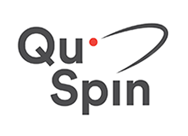Research by our Associated Members - Center for Quantum Spintronics (QuSpin)
Research by our Associated Members
Quantum Computation with Multi-spin Qubits

Theme and goal
The quest for the optimal physical qubit (it should be stable, controllable, and scalable) is at full speed, and by now the research has been narrowed down to a handful of very promising approaches. The research is theoretical, but focuses on practical aspects of such qubit implementations, usually in close collaboration with experimentalists.
Most problems the group is working on are related to questions such as: How could we improve qubit initialization, control, or read-out in a specific setup? What processes dominate qubit decoherence (loss of the quantum aspect of the information)? How could we reduce the effect of these processes?
A large part of this work is in the field of spin qubits in semiconductor quantum dots (small potential traps inside a semiconductor), where the basic idea is to use the spin degree of freedom of the electron as a qubit basis. A recent and particularly interesting proposal is to create such qubits out of multi-particle spin states of electrons localized inside a semiconductor. These so-called exchange-only qubits are conceptually simple and scalable, they rely on well-developed experimental techniques, and can be operated fully electrically. The first attempts to create and operate such a qubit were promising, but also identified obstacles to further progress: Apart from being relatively sensitive to charge noise, exchange qubits couple to the fluctuating spins of the atomic nuclei of the host semiconductor. This coupling leads to decoherence, typically on the scale of tens of nanoseconds.
Key questions
The goal is to solve the intrinsic problem of the nuclear spins and identify the optimal way forward for the exchange-only qubit. Roughly speaking, we are currently investigating two approaches. The first is to find a way to suppress or circumvent the effect of nuclear spin fluctuations in the commonly used III-V materials while keeping the qubit as much protected from charge noise as possible. The second is to determine the optimal implementation of such a qubit in (nuclear-spin-free) silicon.
For current activities, see QuSpin Annual Report 2023.

Frustrated Quantum Antiferromagnets

Theme and goal
Our group’s research centers around lattice models of quantum antiferromagnets, especially models with competing (aka “frustrated”) interactions. In combination with strong quantum fluctuations, frustration may prevent magnetic order and instead lead to other, magnetically disordered phases that possess more exotic types of order that are of great fundamental interest.
Of particular interest are phases known as quantum spin liquids, whose order is not described by broken symmetries but may instead be of a topological nature. In recent years new materials have been discovered which exhibit evidence of unconventional behaviour pointing towards spin-liquid physics.In recent years it has also been realized that various concepts and quantities originating in quantum information theory, like entanglement entropy and fidelity, may be very useful for characterizing quantum many-body phases and the quantum phase transitions between them. Different types of order may give rise to characteristic “signatures” in such quantities and their behaviour as a function of various parameters.
The overall goal is to get a better understanding of the “zoo of phases” that may arise in frustrated quantum anti- ferromagnets, and contribute towards their description and classification.
Key questions
Key questions include whether/where quantum spin liquids arise the phase diagram of various lattice quantum spin models, what types of quantum spin liquids can arise, and how various types of order can manifest themselves through signatures in quantities like entanglement entropy (including both orders that are and are not described by broken symmetries).
For current activities, see QuSpin Annual Report 2023.

Topological Spin Textures

Theme and goal
Chiral magnets develop a wide variety of topological spin textures such as skyrmions, dislocations and disclinations, as well as completely new types of magnetic domain walls. These topological spin textures currently attract worldwide attention due to their unusual and intriguing physical properties.Skyrmions, for example, represent stable nano-sized whirls that give rise to emergent electrodynamics, and their position and motion can be controlled at ultra-low energy costs. Because of these outstanding properties, skyrmions hold great promise for future spintronic devices and neuromorphic computing.
With our research, we go beyond “classical” skyrmion- related studies, exploring the large zoo of topological spin textures available in chiral magnets. We are particularly interested in the physics of magnetic dislocations and disclinations, which naturally occur in the magnetic ground state, i.e, even without the external magnetic field usually needed to stabilize skyrmions. These instabilities share strong similarities with dislocations and disclinations formed by, e.g., crystalline solids, liquid crystals, convection patterns and swimming bacteria.
The goal of our research is to understand the nanoscale physics of such novel topological spin structures and demonstrate emergent functional properties, developing device paradigms into new realms of magnetism.
Key questions
We are interested in the functional properties of completely new types of topological spin textures, including magnetic disclinations and dislocations, and helimagnetic domain walls. By applying state-of-the-art imaging and nano-structuring methods, such as, magnetic force microscopy and focused ion beam, respectively we aim to create fundamental knowledge about the physics of these spin textures: For example, we want to understand their formation process, topology-driven properties, duand interactions. Furthermore, we study how electrical currents and magnetic fields control the position and movement of individual spin textures and investigate the dynamical response. Ultimately, we want to understand of it is possible to utilize the new degrees of flexibility offered by the different topological textures to design next-generation spintronic devices.
For current activities, see QuSpin Annual Report 2023.

Local and Global Magnetodynamic Proporties of Oxides

Theme and goal
Our primary theme is to probe and understand excitations in the charge, spin and lattice and their interactions at the atomic scale. Our primary method for this is through developing excitation spectroscopy techniques, primarily scanning based probe techniques and
other experiments that provide insights into the fate of charge and spin in materials.
Our short-term goal is to explore the magneto- electronics and magnonics of oxide ferromagnets and antiferromagnets. In a more applied context, the long- term goal is to understand and control coupling in the thermal energy scale in order to contribute to the use of thermal energy to communicate information. The longer- term goal on the method side is to develop STM -based point-contact techniques to explore mesoscopic and magneto dynamic physics at a very local scale.
Key questions
Our key primary concern is understanding and probing the excitations and coupling between magnons, phonons and charge carriers at an energy scale that ranges from sub-thermal energies to electron volts. In the spin domain, the prime motif is to understand magnons, and the expression in the form of interacting and propagating magnons and their interaction with charge and phonons. In the phonon regime, we are interested in understanding size and material control and tunability in coupling to the charge and spin excitations.
We are primarily investigating model systems in oxide materials, developing an understanding of perovskite type ferromagnets and anti-ferromagnets, mainly collaborating and seeking collaboration with groups on the material synthesis side to address our key questions.
For current activities, see QuSpin Annual Report 2023.

Work in progress for characterisation of magnetodynamic wave propagation in LSMO striplines.
